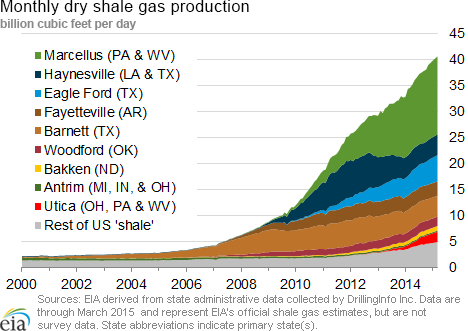In the News:
MATS Rule Takes Effect
The Mercury and Air Toxic Standards (MATS), the EPA rule mandating new environmental standards for coal-fired power plants, took effect on April 16. EIA expects 13 gigawatts (GW) of coal-fired generation capacity to retire this year, much of it occurring this month as MATS takes effect. Most scheduled capacity additions this year are either wind (9.8 GW) or natural gas (4.3 MW). Coal-fired generation capacity accounts for 81% of all planned retirements in 2015.
It's important to note that retiring coal-fired capacity does not necessarily result in a significant change in generation; many of the retiring plants are old and not used much.
The retirements and additions this year represent a long-term trend of declines in coal-fired generation capacity and increases in gas-fired generation capacity. New gas-fired generation has been one of the largest sources of new generation additions over the past few years. Additionally, natural gas generation has helped replace lost nuclear generation following the retirements of two large nuclear facilities, the San Onofre Nuclear Generating Station (SONGS) in Southern California, and Vermont Yankee Nuclear Power Plant in Vermont.
In addition to long-term structural changes to power sector capacity, short term-factors also play a role in the generation mix. While coal-fired plants usually produce baseload electricity, they can be cycled down and dispatched as an intermediate-load generator when natural gas prices fall relative to coal and gas is a more economical choice. EIA projects that because of low prices and expected warmer-than-normal temperatures, average consumption of natural gas for power generation this summer will reach close to a record high of 26.7 billion cubic feet per day (Bcf/d). The record for summer natural gas-fired power generation was set in 2012 , when consumption averaged 27.9 Bcf/d. This was largely because record-high natural gas inventories at the end of March (following a warm winter) contributed to prices in the $2 per million British thermal units (MMBtu) range, which were coupled with an unusually hot summer that raised demand for gas-fired generation to provide air conditioning.
Overview:
(For the Week Ending Wednesday, April 22, 2015)
- Natural gas prices moved up at most market locations through the report week (Wednesday, April 15 — Wednesday, April 22) to post modest gains. Henry Hub spot prices started the week at $2.58 per million British thermal units (MMBtu) last Wednesday, and rose to $2.60/MMBtu yesterday.
- At the New York Mercantile Exchange (Nymex), the near-month (May 2015) natural gas contract opened for the week at $2.610/MMBtu last Wednesday fluctuated slightly through the week, dropping less than 1¢ to close at $2.606/MMBtu yesterday.
- Working natural gas in storage increased to 1,629 Bcf as of Friday, April 17, according to the U.S. Energy Information Administration (EIA) Weekly Natural Gas Storage Report (WNGSR). A net injection into storage of 90 Bcf for the week resulted in storage levels 82.6% above year-ago levels and 5.8% below the five-year average for this week.
- The total rig count for April 17 fell by 34 units to 954 rigs, according to data reported by Baker Hughes Inc. Oil rigs fell by 26 units to 734; gas rigs fell by 8 to 217. The miscellaneous rig count remained the same at 3 units.
- The natural gas plant liquids composite price rose 29¢, increasing 5.5% for the week ending April 17, from $5.35/MMBtu to $5.64/MMBtu from Friday to Friday. All Mont Belvieu NGL spot prices were up this week. Natural gasoline increased 8.8%, ethane prices increased 2.9%, propane rose 4.9% and butane prices increased 3.7%, and isobutane rose 4.4%.
Prices/Demand/Supply:
Cooler weather at the end of the week prompts moderate price increases in most market locations. Prices began the report week relatively low with warmer-than-normal temperatures at most market locations. Cooler temperatures, however, heading from the Midwest to the Northeast, began to arrive at Chicago Citygate on Friday. In trading on Friday, prices at the Chicago Citygate increased 7¢ to $2.61/MMBtu. Chicago Citygate prices continued to rise in response to the chill, ending the report week at $2.67/MMBtu yesterday. Henry Hub spot prices rose from $2.58/MMBtu last Wednesday to $2.64/MMBtu on Friday, dropping back some to close the report week at $2.60 yesterday.
Northeast prices fluctuate, end week up due to cold and constraints. In the Northeast, warmer Spring weather lasted through the weekend. Prices at the Algonquin Citygate, which serves Boston, and Transcontinental Pipeline's Zone 6, serving New York City, started the week near or below Henry Hub. Heading into the weekend, with demand down, both fell more than 80¢ below Henry Hub Despite cooler temperatures during the second half of the report week, Transcontinental Zone 6 New York remained below Henry Hub. In contrast, as the cold returned to New England, prices at the Algonquin Citygate rose back above Henry Hub, reaching $3.57/MMBtu yesterday. In addition to the colder temperatures, Algonquin Gas Transmission (AGT) began conducting maintenance operations on both its Southeast Compressor station, located in Southeast, New York, and on its 30-inch diameter mainline from the Lambertville Meter station, located in Lambertville, New Jersey, to the Hudson River. The maintenance on this section of its 30-inch diameter mainline will reduce flows by about 0.5 Bcf/d.
Marcellus prices remain low. Prices at most Marcellus locations declined this week. At Tennessee's Zone 4 Marcellus trading location, prices dropped from $1.43/MMBtu last Wednesday to $1.14/MMBtu yesterday. On the Transco Leidy Line, prices fell from $1.49/MMBtu last Wednesday to a weekly low of $1.12/MMBtu on Tuesday, recovering to $1.38/MMBtu yesterday. At the Dominion South trading point, which serves customers in portions of Pennsylvania, Ohio, Maryland, West Virginia, and Virginia, prices began the report week at $1.50/MMBtu, fell through Friday to $1.35/MMBtu, then rose to close the week at $1.69/MMBtu yesterday.
Nymex prices flat. The near-month (May 2015) Nymex contract started the week last Wednesday at $2.610/MMBtu, fluctuated up and down through the week, and ended near its start at $2.606/MMBtu yesterday. The 12-month strip (the average of the 12 contracts between May 2015 and April 2016) rose from $2.864/MMBtu last Wednesday to close up 2¢ at $2.889/MMBtu yesterday, along with cooler temperatures.
Total supply remains flat. Total supply this week fell 0.2% from last week, according to data from Bentek Energy. Dry natural gas production increased 0.1% week over week, and was 8% greater than the same time last year. Imports of Canadian natural gas to the United States were down this week by 4.0%. Regionally, imports were mixed. The largest percentage decline in net imports occurred in the Northeast, driven in part, by net exports of natural gas from the United States to Canada occurring on Tuesday and Wednesday, according to Bentek. Net natural gas imports from Canada also fell in the Midwest, and posted modest gains in the West, currently the largest importing region. LNG sendout remained at minimal levels, down 64% from the same week last year.
Consumption declines. Total natural gas consumption fell by 1.7% week over week, with declines coming in all sectors except power. Residential/commercial sectors fell by 5.2%, while industrial consumption fell by 1.1%. Power consumption increased 0.7% for the week, but was up more than 26% over the same period in 2014.
Storage
With more seasonal temperatures, storage injections increase. The net injection reported for the week ending April 17 was 90 Bcf, up from 63 Bcf last week. This compares with the five-year average net increase of 46 Bcf for that week and last year's net increase of 45 Bcf. Working gas inventories for the storage week totaled 1,629 Bcf, 737 Bcf (82.6%) higher than last year at this time and 101 Bcf (5.8%) lower than the five-year (2010-14) average.
Storage injections exceed market expectations. Market expectations, on average, called for a build of 86 Bcf. With the larger-than-expected injection, when the EIA storage report was released at 10:30 a.m. on April 23, the price for the May natural gas futures contract decreased 2¢ to around $2.53/MMBtu in trading on the Nymex.
Although there are many factors that drive storage builds, including competition for available supplies from current consumers and the need for local distribution companies (LDCs) to ensure there are adequate supplies in storage for the upcoming winter withdrawal season, there are methods to evaluate the economic incentives to storing gas. One way is to compare either the natural gas spot price or the near-month futures price with the price at which that gas is valued on the Nymex for the winter. Over the past several years, this difference has been lower than previous years. In April 2013 and April 2014, the average difference in the maximum winter futures contract and April spot prices was 31¢/MMBtu, compared to an average of $2.14/MMBtu in April 2011 and 2012.
From the week ending on April 3 (the beginning of the injection season) through the week ending on April 17, net storage injections have totaled 168 Bcf versus 59 Bcf for the same 3 weeks in 2014, and 79 Bcf for these weeks between 2010 and 2014, on average. The estimated average unit value of what storage holders put into storage from April 3 to April 17 this year was $2.63/MMBtu, 43% lower than the average value for the same 3 weeks last year of $4.61/MMBtu. The highest winter-month Nymex price (for the January 2016 contract) in trading for the week ending on April 17 averaged $3.11/MMBtu. This is 54¢ more than the May Nymex contract price. A year ago, the difference was 21¢/MMBtu, suggesting there is more financial incentive this year to buy and store gas in the summer for sale in the winter.
There are currently 28 more weeks in the injection season, which traditionally occurs April 1 through October 31, although in many years injections continue into November. EIA forecasts that the end-of-October working natural gas inventory level will be 3,781 Bcf, which, as of April 17, would require an average injection of 77 Bcf per week through the end of October. EIA's forecast for the end-of-October inventory levels are below the five-year (2010-14) average peak storage value of 3,813 Bcf. To reach the five-year average peak value, average weekly injections through the end of October would need to be 78 Bcf.
All three regions report net injections for the week. The East, West, and Producing regions had net injections of 41 Bcf (16 Bcf larger than its five-year average injection), 4 Bcf (1 Bcf smaller than its five-year average), and 45 Bcf (29 Bcf larger than its five-year average), respectively. The East and Producing regions' inventories are below their five-year averages by 165 Bcf (22.8%) and 13 Bcf (1.8%), respectively. In contrast, stock levels in the West region are above its five-year average for the week, by 77 Bcf (27.5%). Storage levels for the East, West, and Producing regions are above their year-ago levels by 234 Bcf, 180 Bcf, and 322 Bcf, respectively.
Temperatures during the storage report week warmer than normal. Temperatures in the Lower 48 states averaged 57.0° for the storage report week, 4.7° warmer than the 30-year normal temperature and 2.3° warmer than the average temperature during the same week last year. There were 67 population-weighted heating degree days during the storage report week, 4 fewer than the five-year average and 12 fewer than during the same period last year.
See also:
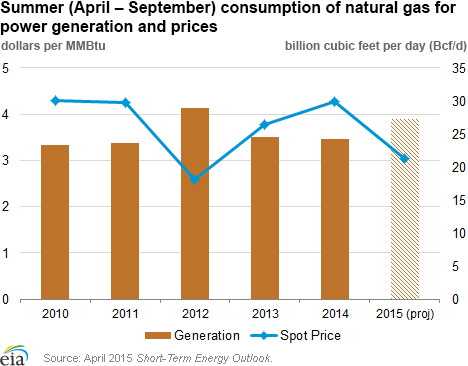
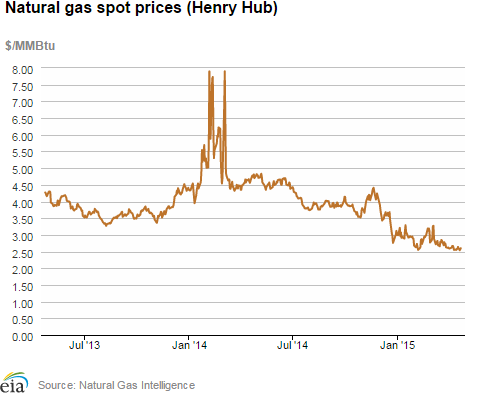
| Spot Prices ($/MMBtu) | Thu, 16-Apr |
Fri, 17-Apr |
Mon, 20-Apr |
Tue, 21-Apr |
Wed, 22-Apr |
|---|---|---|---|---|---|
| Henry Hub |
2.58 |
2.64 |
2.54 |
2.57 |
2.60 |
| New York |
2.02 |
1.76 |
2.20 |
2.51 |
2.59 |
| Chicago |
2.53 |
2.61 |
2.59 |
2.65 |
2.67 |
| Cal. Comp. Avg,* |
2.52 |
2.55 |
2.55 |
2.59 |
2.64 |
| Futures ($/MMBtu) | |||||
| May contract |
2.684 |
2.634 |
2.536 |
2.575 |
2.606 |
| June contract |
2.726 |
2.679 |
2.578 |
2.620 |
2.654 |
| *Avg. of NGI's reported prices for: Malin, PG&E citygate, and Southern California Border Avg. | |||||
| Source: NGI's Daily Gas Price Index | |||||
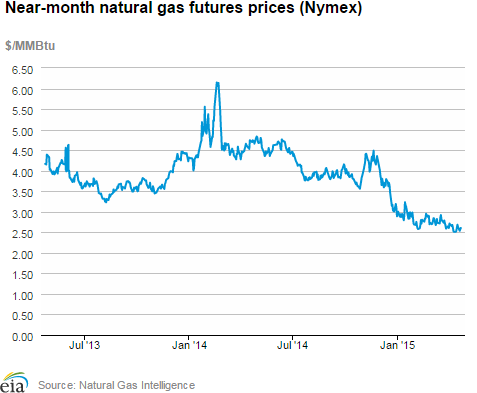
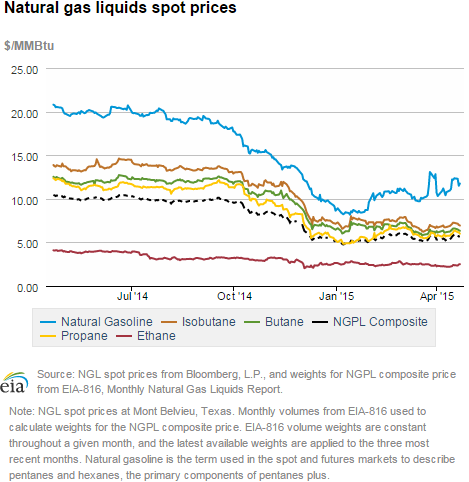
| U.S. natural gas supply - Gas Week: (4/15/15 - 4/22/15) | ||
|---|---|---|
Percent change for week compared with: |
||
last year |
last week |
|
| Gross production | 8.05%
|
0.10%
|
| Dry production | 7.98%
|
0.10%
|
| Canadian imports | 11.36%
|
-4.03%
|
| West (net) | 33.28%
|
0.45%
|
| Midwest (net) | 13.09%
|
-4.23%
|
| Northeast (net) | -121.32%
|
-277.81%
|
| LNG imports | -64.18%
|
-7.08%
|
| Total supply | 8.07%
|
-0.18%
|
| Source: BENTEK Energy LLC | ||
| U.S. consumption - Gas Week: (4/15/15 - 4/22/15) | ||
|---|---|---|
Percent change for week compared with: |
||
last year |
last week |
|
| U.S. consumption | 0.1%
|
-1.7%
|
| Power | 26.4%
|
0.7%
|
| Industrial | -3.4%
|
-1.1%
|
| Residential/commercial | -17.3%
|
-5.2%
|
| Total demand | 0.7%
|
-1.7%
|
| Source: BENTEK Energy LLC | ||
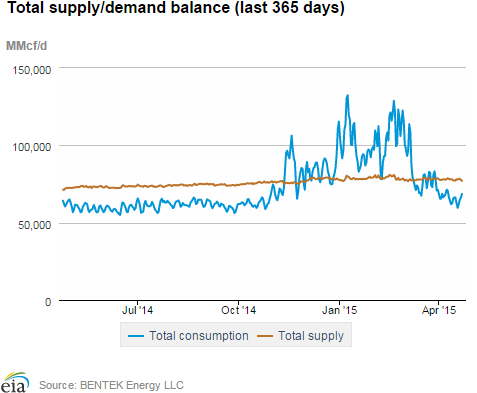
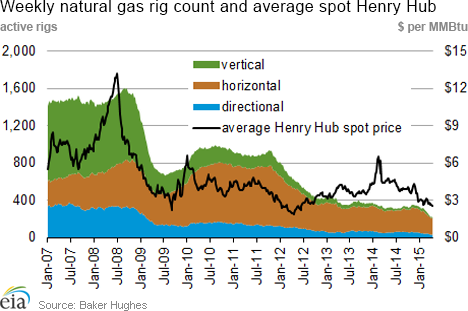
| Rigs | |||
|---|---|---|---|
Fri, April 17, 2015 |
Change from |
||
last week |
last year |
||
| Oil rigs | 734 |
-3.42% |
-51.39% |
| Natural gas rigs | 217 |
-3.56% |
-31.33% |
| Miscellaneous | 3 |
0.00% |
-40.00% |
| Rig numbers by type | |||
|---|---|---|---|
Fri, April 17, 2015 |
Change from |
||
last week |
last year |
||
| Vertical | 122 |
-4.69% |
-68.80% |
| Horizontal | 741 |
-3.77% |
-39.46% |
| Directional | 91 |
1.11% |
-57.87% |
| Source: Baker Hughes Inc. | |||
| Working gas in underground storage | ||||
|---|---|---|---|---|
Stocks billion cubic feet (bcf) |
||||
| Region | 2015-04-17 |
2015-04-10 |
change |
|
| East | 560 |
519 |
41 |
|
| West | 357 |
353 |
4 |
|
| Producing | 712 |
667 |
45 |
|
| Total | 1,629 |
1,539 |
90 |
|
| Source: U.S. Energy Information Administration | ||||
| Working gas in underground storage | |||||
|---|---|---|---|---|---|
Historical comparisons |
|||||
Year ago (4/17/14) |
5-year average (2010-2014) |
||||
| Region | Stocks (Bcf) |
% change |
Stocks (Bcf) |
% change |
|
| East | 326 |
71.8 |
725 |
-22.8 |
|
| West | 177 |
101.7 |
280 |
27.5 |
|
| Producing | 390 |
82.6 |
725 |
-1.8 |
|
| Total | 892 |
82.6 |
1,730 |
-5.8 |
|
| Source: U.S. Energy Information Administration | |||||
| Temperature -- heating & cooling degree days (week ending Apr 16) | ||||||||
|---|---|---|---|---|---|---|---|---|
HDD deviation from: |
CDD deviation from: |
|||||||
| Region | HDD Current |
normal |
last year |
CDD Current |
normal |
last year |
||
| New England | 110
|
-29
|
-7
|
0
|
0
|
0
|
||
| Middle Atlantic | 94
|
-28
|
4
|
0
|
0
|
0
|
||
| E N Central | 83
|
-42
|
-36
|
0
|
0
|
0
|
||
| W N Central | 76
|
-40
|
-55
|
0
|
-1
|
0
|
||
| South Atlantic | 37
|
-23
|
-8
|
36
|
22
|
17
|
||
| E S Central | 26
|
-29
|
-26
|
11
|
6
|
7
|
||
| W S Central | 19
|
-6
|
-21
|
28
|
9
|
10
|
||
| Mountain | 103
|
-13
|
7
|
5
|
-2
|
-5
|
||
| Pacific | 52
|
-16
|
23
|
0
|
-3
|
-1
|
||
| United States | 67
|
-27
|
-12
|
11
|
6
|
4
|
||
|
Note: HDD = heating degree-day; CDD = cooling degree-day Source: National Oceanic and Atmospheric Administration | ||||||||
Average temperature (°F)
7-Day Mean ending Apr 16, 2015
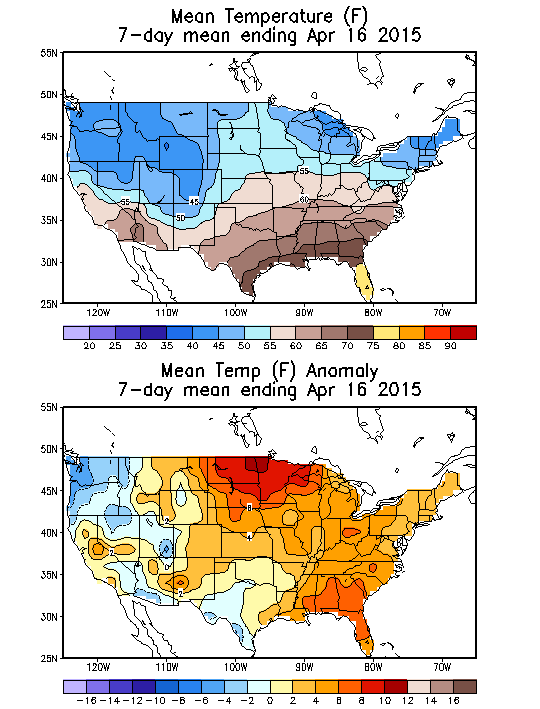
Source: NOAA/National Weather Service
Deviation between average and normal (°F)
7-Day Mean ending Apr 16, 2015

Source: NOAA/National Weather Service

